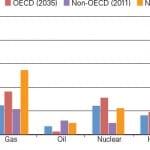Global emissions of carbon dioxide (CO2) from coal-fired power plants and industrial facilities fell in 2019, according to research published Dec. 3, though overall emissions of CO2 rose due to the increased use of natural gas and oil for power generation and other industrial processes.
The new emissions figures were reported by the Global Carbon Project (GCP), part of Future Earth and a research partner of the World Climate Research Programme. GCP was formed in 2011 to work with scientists and establish a database to support policy debate and action to slow greenhouse gas emissions. The group released its latest findings at the COP 25 United Nations climate change summit in Madrid, Spain, being attended by representatives from about 190 countries.
The GCP, in its “Global Carbon Budget 2019,” said global emissions from coal dropped 0.9% this year. Industrial emissions of all types are on pace to rise 0.6% this year, a slower increase than the 2.1% rise in 2018 and the 1.5% increase in 2017. The U.S. and the European Union (EU) both saw their CO2 emissions drop this year, both falling about 1.7%, as each country continues to close coal-fired power plants and the U.S. employs new technologies to reduce emissions at coal plants.
Emissions from power plants have fallen dramatically over the past 30 years after the passage of major amendments to the Clean Air Act. This year’s drop in the U.S. comes after the country’s CO2 emissions increased 2.8% a year ago, according to GCP. Other groups also reported emissions rose in 2018, due in part to Trump administration rollbacks of Obama-era pollution controls.
Global Warming Remains a Threat
The GCP 2019 report, published simultaneously Tuesday in three scientific journals, warned that even small increases in annual emissions levels will not reverse the trend of global warming and changes in the world’s climate.
“Every year that emissions go up, even if it’s just a small amount, makes the task of bringing them back down that much harder,” Glen Peters, research director at the Center for International Climate Research in Oslo, Norway, told The New York Times. Peters helped compile the data for the report.
“The weak growth in carbon dioxide emissions in 2019 is due to an unexpected decline in global coal use, but this drop is insufficient to overcome the robust growth in natural gas and oil consumption,” said Peters, who noted global CO2 emissions from fossil fuels would likely be more than 4% higher this year than in 2015, the year when the Paris Agreement to establish emissions reduction goals to combat climate change was adopted.
“While this is a moment of good news, there remains a need for rapid and large reductions in the amount of fossil fuels consumed by energy and transportation systems, both here in the U.S. and around the world,” Peter Schultz, PhD, vice president at ICF, told POWER. ICF is a global consulting and technology services services company headquartered in Fairfax, Virginia. “We must collectively get on a pathway toward stabilizing the level of carbon dioxide in the atmosphere to avoid the most severe impacts of climate change,” said Schultz.
The GCP data shows that natural gas is now the biggest driver of increased emissions. Gas is now the largest source of power generation in the U.S., and other countries have increased their reliance on the fuel. For example, Japan relies on imports of natural gas to replace the electricity generation lost when the country closed its carbon-free nuclear power plants after the 2011 disaster at the Fukushima Daiichi nuclear station. Fewer than a dozen of those plants have been restarted.
Peters told the Times: “Natural gas may produce fewer carbon emissions than coal, but that just means you cook the planet a bit more slowly. And that’s before even getting into the worries about methane leaks” from gas infrastructure.
The GCP said China is responsible for 26% of the world’s CO2 emissions annually, with the U.S. next at 14%. The EU accounts for 9%, and India for 7%. The report said China’s emissions are expected to increase about 2.6% this year as the country uses more natural gas in its industrial sector, as China tries to stimulate a slowing economy.
—Darrell Proctor is a POWER associate editor (@DarrellProctor1, @POWERmagazine).










